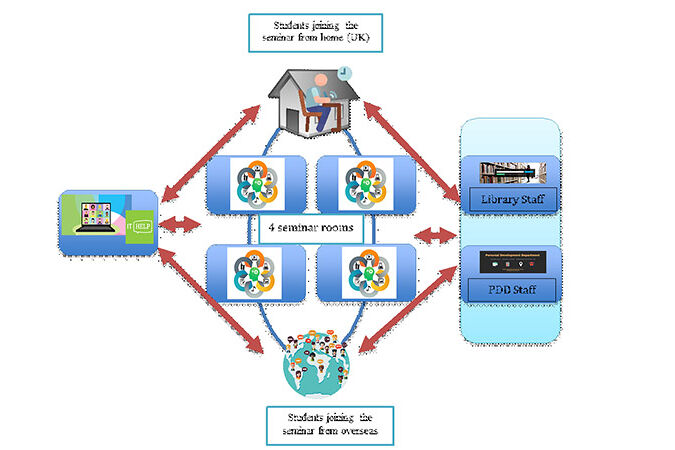
Blog Article

AI technologies can be found in much of what we consume today, including social media, streaming services, digital games, online shopping, and smart technologies. However, AI can have the greatest impact on today’s children “from how they are conceived, to the services they can access, how they learn, and the jobs they will train for” (Unicef, 2018). Concerned about the uncertainties around AI and its potential impact on children and young people, Unicef launched ‘Generation AI’ in 2018 to work with them and major stakeholders in the field. Governments and technology giants have also been working on initiatives and programmes to prepare the young generation for this future AI-driven world.
Authors
- Dr Vanessa Cui, Research Fellow
- Dr Louise Wheatcroft
In the UK, the Government’s Office for AI published its AI Roadmap document in 2021. For the first time, it recognised that learning and teaching AI is no longer a specialist subject for secondary+ young people. The Council’s vision is “for everyone to be able to live confidently with AI, and for those who go on to work with it and to build it do so with the very best foundation.”
AI in education, AI literacy and Pedagogy
Much of AI in education has been focusing on the use of AI for learning and teaching. The pedagogical discussion has been around how theories such as constructionism, social constructionism are put into practice in the development of educational AI tools (e.g. PopBots). This is an important issue to consider as AI-driven technologies become more mainstream in formal and informal educational contexts.
The other emerging dimension of AI in education is AI literacy. AI literacy is the terminology currently used in policies and by AI education specialists to describe the competencies necessary in a future in which AI transforms the way that we communicate, work, and live with each other and with machines (Long and Magerko, 2020). This involves both using AI for learning and teaching and the learning and teaching of AI. Using Haberman’s categorisation of knowledge by human interests, AI literacy could be understood as skills and technical abilities; applications and practical considerations; and transformative thinking, experiences and considerations.
So far, major initiative and projects in the UK, US, Australia and China are mainly driven by content and the technologies application (e.g. natural language processing, machine learning, image recognition). What’s quite common is that most of the resources/programmes were designed by experts/researchers in the field of AI and/or AI education, some have teacher input often in the form of feedback to pilot programmes. This was noted by Mavrikis in his 2019 BERA conference presentation where he called for greater involvement and contribution from teachers in AI education.
Learning and teaching AI in primary context
Considerations and implementations of learning and teaching AI in a primary context is in a very early phase. Literature on AI and AI literacy learning and teaching outline several key areas for primary schools, practitioners and families to consider (Ali et al, 2019; Payne, 2019; Touretzky et al, 2019; Demirkol, 2018). These include programming and computational thinking, ethics, and creativity.
In recent years, there has been advancement in programming and computational thinking education for primary age children thanks to work carried out by subject specialists and national programmes. While the UK AI Council’s version and recommendations are for education of all levels to teach and learn AI. So far, much of this work has been led by National Centre for Computing Education (NCCE) on the development of teachers’ knowledge, skills and resources. The take-up and implementation of the NCCE programmes and resources are yet to be widespread across primary education in the UK.
As identified by Unicef, AI can impact society and individuals in both positive and negative ways and with many unintended consequences. Currently, children and young people are experiencing a wide range of technologies driven by AI, but we don’t know whether children can identify examples of AI in their everyday life; how they understand the value of using AI; and how AI affects their lives. Over the years, many have been calling for a broadening of literacy skills that include critical literacies and whilst digital citizenship is included within the primary computing curriculum and encourages children to interact online more thoughtfully, it is also time to combine children’s critical literacy and digital literacy skills to address these ethical issues.
While it’s valuable that children learn about how the AI systems in our current world works and its impact on society and individually, it is also important for them to think about what they want AI to be like and how it should work. As an emerging field of technology, its future development and implementation is shaped by future generations. In his latest publication, Demirkol (2019) noted the future world with AI as a key part of our work and everyday life will change the way humans think and act. While it is difficult to predict a world of people with such changed ways of thinking and acting, Demirkol pointed out that creative thinking will be key. He also suggests in this highly creative and productive society, learning will become a lifestyle.
Concluding thoughts
Returning to the UK AI Council’s roadmap, it suggests:
“Overtime, AI needs to be built into the curriculum as a specialist subject. As well as being its own subject AI needs to be part of computer science, citizenship studies, and as part of new ways of doing other subjects such as geography or history.”
While the literature provides some useful examples and thought-provoking suggestions regarding AI and AI literacy education for primary schools, there are a number of key questions needing to be addressed before we move further with introducing and implementing AI and AI literacy in primary education. The voice and experiences of teachers have only been included in a very limited capacity to date on this issue, so the aim of this blog post is to be a catalyst for teachers, student teachers, teacher educators and other education practitioners to consider the role primary education has in AI and AI literacy education.
With this blog post, we invite teachers, student teachers and teacher educators to this year’s CSPACE conference to discuss the following:
- Should primary education explicitly address AI and AI literacy?
- What needs/should be included in primary curriculum in relation to AI and AI literacy?
- How should the knowledge and learning experiences be organised at the primary education level?
- What do teachers need to know in terms of subject knowledge, pedagogical knowledge and support to implement the AI curriculum?
- Could families and the wider community be involved in this AI learning and teaching for primary age children? If so, how?
Further reading
- Ali, S., Payne, B. H., Williams, R., Park, H. W. and Breazeal, C. (2019) Constructionism, ethics, and creativity: developing primary and middle school artificial intelligence education. http://robotic.media.mit.edu/wp-content/uploads/sites/7/2019/08/Constructionism__Ethics__and_Creativity.pdf
- Touretzky, D., Gardner-McCune, C., Martin, F. and Seehorn, D. (2019) Envisioning AI for K12: What should every child know about AI? The Thirty-Third AAAI Conference on Artificial Intelligence (AAAI-19). https://ojs.aaai.org//index.php/AAAI/article/view/5053
- Payne, B. H. 2019. An Ethics of Artificial Intelligence Curriculum for Middle School Students. MIT Media Lab. https://docs.google.com/document/d/1e9wx9oBg7CR0s5O7YnYHVmX7H7pnITfoDxNdrSGkp60/edit#heading=h.ictx1ljsx0z4
- Mavrikis, M. 2020. AI in classrooms: the need for teachers-in-the-loop. Great Expectations – what should artificial intelligence be doing for us? BERA. https://www.bera.ac.uk/event/great-expectations
- Demirkol, Z. 2018. Coding for kids. Harman, G. (translator). Istanbul: Pusula.




